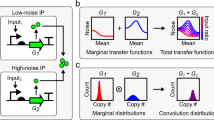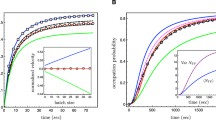Abstract
Intrinsic noise is inherent to many biological processes and provokes variation in gene expression in a population of isogenic cells leading to phenotypic diversity. Intrinsic noise is generated by different sources of noise such as the number of molecules, the stochastic binding and unbinding of transcription factor and/or the number and strength of transcription factor binding sites. In this work, we use numerical simulations to study the effects of the number of operators and different types of cooperativity on the Fano factor of three different molecules of the tryptophan (trp) operon of E. Coli. We analyze the Fano factor for the mRNA, anthranilate synthase and tryptophan molecules, because it represents the effects of the noise in the variation or variability of the gene expression, a larger Fano factor implies a larger variation. Our model takes into consideration the presence of intrinsic noise and all the known mechanisms of regulation. In particular, we consider hypothetical promoters in the repression mechanism with different numbers of operators and three cases of cooperativity: positive, negative, and no-cooperativity.
Similar content being viewed by others
References
Waite, A.J., Frankel, N.W., Emonet, T.: Behavioral variability and phenotypic diversity in bacterial chemotaxis. Annu. Rev. Biophys. 47, 595–616 (2018)
Grillo, A.O., Brown, M.P., Royer Catherine, A.: Probing the physical basis for trp repressor-operator recognition. J Mol Biol 287, 539–554 (1999)
Isakova, A., Hatzimanikatis, V., Berset, Y., Bart, D.: Quantification of cooperativity in heterodimer-dna binding improves the accuracy of binding specificity models. J. Biol. Chem. 291(19), 10293–10306 (2016)
Allewell, N.M.: Transcarbamoylase: structure, energetics, and catalytyc and regulatory mechanism. Annu. Rev. Biophys. Biophys. Chem. 18, 71–92 (1989)
Bialek, W., Setayeshgar, S.: Cooperativity, sensitivity, and noise in biochemical signaling. Phys. Rev. Lett. 100(258101), 1–4 (2008)
Munsky, B., Neuert, G., van Oudenaarden, A.: Using gene expression noise to understand gene regulation. Science 336(6078), 183–187 (2012)
Brown, B.: P22 Arc–energetics and Cooperativity of DNA Binding, Massachusetts Institute of Technology. Department of Biology (1994)
Eaton, B.E., Gold, L., Zichi, D.A.: Let’s get specific: the relationship between specificity and affinity. Chem. Biol. 2, 633–638 (1995)
Bush, E.C., Clark, A.E., DeBoever, C.M., Haynes, L.E., Hussain, S., et al.: Modeling the role of negative cooperativity in metabolic regulation and homeostasis. PLos ONE 7(11), 1–6 (2012)
Cervera, J., Manzanares, J.A., Mafe, S.: The interplay between cooperativity and diversity in model threshold ensembles, J R Soc Interface 11(99), 1–7 (2014)
Cui, Q., Karplus, M.: Allostery and cooperativity revisited. Protein Sci. 17, 1295–1307 (2008)
Murrugarra, D., Veliz-Cuba, A., Aguilar, B., Arat, S., Laubenbacher, R.: Modeling stochasticity and variability in gene regulatory networks. EURASIP J. Bioinforma. Syst. Biol. 5, 1–11 (2012)
Ferrell, J.E.: Q&a: Cooperativity. J. Biol. 8(6), 53 (2009)
Gonze, D., Grard, C., Wacquier, B., Woller, A., Tosenberger, A, Goldbeter, A., Dupont, G.: Modeling-based investigation of the effect of noise in cellular systems, Frontiers in Molecular Biosciences 5(34), 1–12 (2018)
Aramaki, H., Kabata, H., Takeda, S., Itou, H., Nakayama, H., Shimamoto, N.: Formation of repressor-inducer-operator ternary complex: negative cooperativity of d-camphor binding to camr. Genes Cells 16, 1200–1207 (2011)
Golding, I., Paulsson, J., Zawilski, S.M., Cox, E.C.: Real-time kinetics of gene activity in individual bacteria. Cell 123(6), 1025–1026 (2005)
Barnes, I.W., Turner, D.H.: Long-range cooperativity in molecular recognition of rna by oligodeoxynucleotides with multiple c5-(1-propynyl) pyrimidines. J. Am. Chem. Soc. 123(18), 4107–4118 (2001)
Peacock, J., Jaynes, J.B.: Using competition assays to quantitatively model cooperative binding by transcription factors and other ligands. Biochim. Biophys. Acta 1861(11), 2789–2801 (2017)
Yang, J., Gunasekera, A., Lavoie, T.A., Lewis, L.J.D.E.A., Carey, J.: In vivo and in vitro studies of trpr-dna interactions. J. Mol. Biol. 258, 37–52 (1996)
Shenker, J.Q., Lin, M.M.: Cooperativity leads to temporally-correlated fluctuations in the bacteriophage lambda genetic switch. Front. Plant Sci. 6, 1–10 (2015)
Koshland, D.E. Jr, Hamadani, K.: Proteomics and models for enzyme cooperativity. J. Biol. Chem. 277(49), 46841–46844 (2002)
Norregaard, K., Andersson, M., Sneppen, K., Nielsen, P.E., Brown, S., Oddershedea, L.B.: Dna supercoiling enhances cooperativity and efficiency of an epigenetic switch. PNAS 110(43), 17386–17391 (2013)
Koh, R.S., Dunlop, M.J.: Modeling suggests that gene circuit architecture controls phenotypic variability in a bacterial persistence network. BMC Syst. Biol. 6 (47), 1–9 (2012)
Krejci, A., Tucek, S.: Changes of cooperativity between n-methylscopolamine and allosteric modulators alcuronium and gallamine induced by mutations of external loops of muscarinic m3 receptors. Mol. Pharmacol. 60(4), 761–767 (2001)
Lei, Q.-L., Ren, C.-L., Su, X.-H., Ma, Y.-Q.: Crowding-induced cooperativity in dna surface hybridization. Sci. Rep. 5, 1–7 (2015)
Levitzki, A., Koskland, D.E. Jr: Negative cooperativity in regulatory enzymes. PNAS 62(4), 1121–1128 (1969)
Liu, J.Y.: Modeling the Effect of Cooperativity on Ligand-Driven Fluctuations of Metabotropic Glutamate Receptors, Master’s thesis. College of William and Mary (2015)
Agnati, L.F., Tarakanov, A.O., Guidolin, D.: A simple mathematical model of cooperativity in receptor mosaics based on the ”symmetry rule”. BioSystem 80, 165–173 (2005)
Tabaka, M., Cybulski, O., Holyst, R.: Accurate genetic switch in escherichia coli Novel mechanism of regulation by co-repressor. J. Mol. Biol. 377, 1002–1014 (2008)
Merino, F., Bouvier, B., Cojocaru, V.: Cooperative dna recognition modulated by an interplay between protein-protein interactions and dna-mediated allostery. PLoS Comput. Biol. 11(6), 1–23 (2015)
Jørgensen, G.M., Raaphorst, R., Veening, J.-W.: Noise and Stochasticity in Gene Expression: A Pathogenic Fate Determinant, vol. 40 Elsevier, chap 6 (2013)
Mora, T., Walczak, A.M.: Effect of phenotypic selection on stochastic gene expression. J. Phys. Chem. B 117(42), 13194–13205 (2013)
Pan, Y., Nussinov, R.: Cooperativity dominates the genomic organization of p53-response elements: A mechanistic view. PLoS Comput. Biol. 5(7), 1–11 (2009)
Choi, P.J., Cai, L., Frieda, K., Sunney Xie, X.: A stochastic single-molecule event triggers phenotype switching of a bacterial cell. Science 322(5900), 442–446 (2008)
Liu, P., Song, R., Elison, G.L., Peng, W., Acar, M.: Noise reduction as an emergent property of single-cell aging. Nat. Commun. 8(1), 1–13. Article ID 680 (2017)
Porter, C.M., Miller, B.G.: Cooperativity in monomeric enzymes with single ligand-binding sites. Bioorg. Chem. 43, 44–50 (2012)
Rudnick, J., Bruinsma, R.: Dna-protein cooperative binding through variable-range elastic coupling. Biophys. J. 76, 1725–1733 (1999)
Salazar-Cavazos, E., Santillán, M.: Optimal performance of the tryptophan operon of e. coli: a stochastic, dynamical, mathematical-modeling approach. Bull. Math. Biol. 76(2), 314–334 (2014)
Sanchez, A., Garcia, H.G., Jones, D., Phillips, R., Kondev, J.: Effect of promoter architecture on the cell-to-cell variability in gene expression. PLoS Comput. Biol. 7(3), 1–20 (2011)
Santillán, M.: On the use of the hill functions in mathematical models of gene regulatory networks. Math. Model Nat. Phenom. 3(2), 85–97 (2008)
Senear, D.F., Brenowitz, M.: Determination of binding constants for cooperative site-specific protein-dna interactions using the gel mobility-shift assay. J. Biol. Chem. 266(21), 13661–13671 (1991)
Singh, A., Soltani, M.: Quantifying intrinsic and extrinsic variability in stochastic gene expression models. PLoS ONE 8(12), 1–12 (2013)
Owen-Hughes, T., Workman, J.L.: Experimental analysis of chromatin function in transcription control. Crit. Rev. Eukaryot. Gene Expr. 4, 403–441 (1994)
Thattai, M., van Oudenaarden, A.: Intrinsic noise in gene regulatory networks. PNAS 98(15), 8614–8619 (2001)
Tkacik, G., Gregor, T., Bialek, W.: The role of input noise in transcriptional regulation. PLoS ONE 3(7), 1–11 (2008)
Tsimring, L.S.: Noise in biology. Rep. Prog. Phys. 77(2), 1–62 (2014)
Teslenko, V.I., Kapitanchuk, O.L., Yang, Z.: Controlling cooperativity of a metastable open system coupled weakly to a noisy environment. Chin. Phys. B 24 (2), 1–12. Article ID 028702 (2015)
Yan, C., Wu, S., Pocetti, C., Bai, L.: Regulation of cell-to-cell variability in divergent gene expression, Nature communications 7(11099 EP -), 1–10 (2016)
Taniguchi, Y., Choi, P.J., Li, G.-W., Chen, H., Babu, M., Hearn, J., Emili, A., Sunney Xie, X.: Quantifying e. coli proteome and transcriptome with single-molecule sensitivity in single cells. Science 329(5991), 533–538 (2010)
Author information
Authors and Affiliations
Corresponding author
Additional information
Communicated by: Pavel Solin
Publisher’s note
Springer Nature remains neutral with regard to jurisdictional claims in published maps and institutional affiliations.
Rights and permissions
About this article
Cite this article
Cantú-González, J.R., Díaz-Hernández, O., Ramírez-Álvarez, E. et al. A computational study of the gene expression in the tryptophan operon with two types of cooperativity. Adv Comput Math 45, 1843–1851 (2019). https://doi.org/10.1007/s10444-018-09661-x
Received:
Accepted:
Published:
Issue Date:
DOI: https://doi.org/10.1007/s10444-018-09661-x




